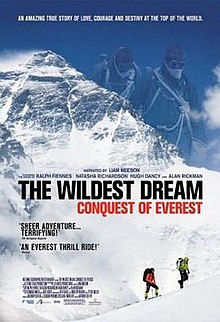The Wildest Dream
| The Wildest Dream | |
|---|---|
 | |
| Directed by | Anthony Geffen |
| Produced by | Anthony Geffen Mike Medavoy Claudia Perkins |
| Written by | Mark Halliley |
| Starring | Conrad Anker Leo Houlding Ralph Fiennes Natasha Richardson Hugh Dancy Alan Rickman |
| Narrated by | Liam Neeson |
| Music by | Joel Douek |
| Cinematography | Chris Openshaw Ken Sauls |
| Edited by | Peter Miller |
Production company | Altitude Films with Atlantic Productions |
| Distributed by | Serengeti Entertainment National Geographic Entertainment |
Release date |
|
Running time | 94 minutes |
| Country | United States |
| Language | English |
| Box office | $873,594 (USA) |
The Wildest Dream is a 2010 theatrical-release feature documentary film about the British climber George Mallory who disappeared on Mount Everest in 1924 with his climbing partner Andrew Irvine. The film interweaves two stories, one about climber Conrad Anker (who discovered Mallory's body lying on Everest in 1999) returning to Everest to investigate Mallory's disappearance and the other a biography of Mallory told through letters (read by Ralph Fiennes and Natasha Richardson), original film footage from the 1920s and archival photos. The film was released in the US and on giant screen cinemas around the world by National Geographic Entertainment in August 2010 as The Wildest Dream: Conquest of Everest. The film was released in the UK by Serengeti Entertainment in September 2010 as The Wildest Dream.
This was Natasha Richardson's last film. She recorded her voice-over as Ruth Mallory two months before her death on 18 March 2009.
Cast[edit]
- Conrad Anker
- Hugh Dancy as Andrew Irvine (voice)
- Ralph Fiennes as George Mallory (voice)
- Leo Houlding
- Liam Neeson as Narrator (voice)
- Natasha Richardson as Ruth Mallory (voice)
- Alan Rickman as Noel Odell (voice)
Synopsis[edit]
In 1924 mountaineer George Mallory was torn between love for his wife Ruth, and his obsession with the last great adventure left to man: becoming the first person to reach the summit of the untouched Mount Everest.
Dressed in gabardine and wearing hobnailed boots, Mallory risked everything in pursuit of his dream, but was last seen alive 800 feet below the summit. Then the clouds rolled in and he disappeared.
After discovering Mallory’s body on Everest in 1999, modern climber Conrad Anker’s life became intertwined with Mallory’s story. Mallory’s frozen body was found with his belongings intact; the only thing missing was a photograph of Ruth, which Mallory had promised to place on the summit. Haunted by Mallory's story, Anker returns to Everest with British climbing prodigy Leo Houlding to discover the truth about Mallory and to unravel the mysteries surrounding his disappearance.
Anker and his climbing partner take on the Second Step without the use of the fixed ladder; free climbing it with the use of some modern safety precautions (e.g. perlon rope, camming devices, belay devices), to evaluate if indeed Mallory was capable of climbing the Second Step himself in 1924.
Critical reception[edit]
The film won the award for Best Adventure Film at the Boulder International Film Festival. It has received a score of 76% on the critics' Tomatometer on the Rotten Tomatoes website.[1]
The film received numerous positive reviews from critics when it was released in the US. Andrew Barker in Variety described the film as "gorgeous looking", writing that "the film contains a number of awe-inspiring shots and a wonderful, computer-generated guided illustration of the entire path the explorers took up the mountain".[2] Kenneth Turan wrote in the Los Angeles Times that the film "adroitly mixes a variety of material" while "narrator Liam Neeson and reading voices Natasha Richardson, Hugh Dancy and Alan Rickman do exceptionally strong work".[3] Pam Grady of Boxoffice raved about the film and wrote "It is a moving tale and a breathtaking sight."[4]
The film also got a strong critical reaction in the UK. Anna Smith in Empire commented that "the tale of Mallory’s fatal ascent is well told, the mountain photography is spectacular and rare archive film recalls a time when the world still had peaks to conquer".[5] Carmen Gray described it as "captivating and seductive" in Sight & Sound although she felt that "the equivalence of the journeys often seems forced".
References[edit]
- ^ Tomatometer for The Wildest Dream at Rotten Tomatoes. Rotten Tomatoes. Retrieved 2013-2-5.
- ^ The Wildest Dream: Conquest of Everest (2010-06-23). Variety. Retrieved 2010-11-29.
- ^ Movie Review: 'The Wildest Dream' (2010-08-06). Los Angeles Times. Retrieved 2010-11-29.
- ^ Sparktech Software LLC (2010-08-06). The Wildest Dream: Conquest of Everest - Inside Movies Since 1920. Retrieved 2010-09-14.
- ^ "Review of The Wildest Dream: Conquest of Everest". Empireonline.com. 2006-12-05. Retrieved 2010-12-02.
See also[edit]
External links[edit]
- 2010 films
- English-language films
- American biographical films
- American films
- Documentary films about historical events
- Films shot in Montana
- Films shot in Nepal
- Films about Mount Everest
- IMAX films
- Mountaineering films
- Documentary films about climbing
- American documentary films
- National Geographic Society films
- 2010s documentary films
- IMAX documentary films

